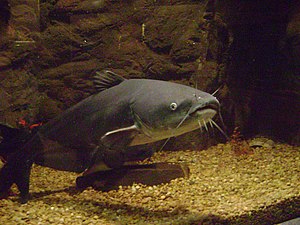 Image via Wikipedia
Image via WikipediaMDC biologists recently began the second year of a blue catfish study at Truman Lake and Lake of the Ozarks as regulations are considered to protect intermediate-sized fish from overharvest and boost the numbers of larger catfish.
The goal is to gather data for a three-year study on blue catfish sizes, population and growth rates. MDC crews will run jug lines through late autumn. The catfish caught will be weighed, measured and released. Biologists will also remove spines from a certain number of fish within a range of sizes to gather age and growth information.
Since the late 1980s, anglers and Conservation Agents have expressed concerns about declining numbers of large blue catfish in Truman Lake. The same concerns have arisen in recent years at Lake of the Ozarks. Blue catfish population numbers remain healthy. But as fishing pressure has increased, the number of fish in the 20- to 80-pound range has declined. The chance to catch a very large fish is why many anglers seek blue catfish with jug lines, trot lines or rod and reel.
Anglers can currently keep 5 blue catfish of any size daily on Truman Lake, Lake Ozark and their tributaries. In the no-boating zone below Truman Dam, anglers can currently keep an aggregate (combination of blue, flathead or channel catfish) of 4 catfish daily and only one of those can be larger than 24 inches.
Regulations are being considered on all these waters that would increase the daily creel limit to 10 blue catfish. Also, a slot limit would require anglers to release unharmed fish in a range that would weigh from 5-7 pounds on up to 15-17 pounds in size. Any slot regulation proposed would be in inches, but outlining it in pounds gives anglers a good idea of the size of fish the regulations being considered would protect. Anglers would be allowed to keep one or two large fish above the slot limit.
The change would increase the total number of blue catfish anglers could keep and eat, and it would still allow for a limited number of large blues to be taken by each angler daily.
Returning fish within the protected size range would allow more blue catfish to reach their large size potential.
“Blue catfish are popular on both of these lakes and catfishing is important to the economy of the region,” said Mike Bayless, MDC fisheries biologist. “The regulations we are considering are a balance between improving the quality of the fishery while still letting anglers take home fish to eat and keeping people coming to these lakes long into the future. We realize that citizen input is a critical part of changing any regulation and we want to hear what people think.”
Anglers may contact Bayless regarding Truman Lake catfish at 660-885-6981, Ext. 253,Mike.Bayless@mdc.mo.gov. For Lake of the Ozarks, anglers may contact Greg Stoner at 573-346-2210, ext. 235,Greg.Stoner@mdc.mo.gov.
The current study will add to data and feedback from anglers gathered earlier.
An MDC harvest evaluation conducted on Truman Lake from 2004 to 2008 documented a high rate of n harvest by anglers for intermediate-sized blue catfish. Blue catfish reproduction is good, but the high harvest rate affects the quality of a fishery where many anglers enjoy the chance to catch very large catfish.
harvest by anglers for intermediate-sized blue catfish. Blue catfish reproduction is good, but the high harvest rate affects the quality of a fishery where many anglers enjoy the chance to catch very large catfish.
At the same time, response to MDC angler surveys have shown that many people who enjoy target catfish at Truman Lake are concerned about a drop in the numbers of large fish. Most recently MDC biologists have heard similar concerns from anglers at Lake of the Ozarks.
The blue catfish population study currently underway will establish more baseline data, so if new regulations are approved, biologists can repeat the same study 7 or 8 years later and see how the change affected the fishery.
-Bill Graham-





No comments:
Post a Comment